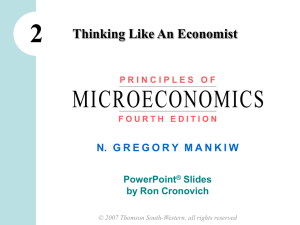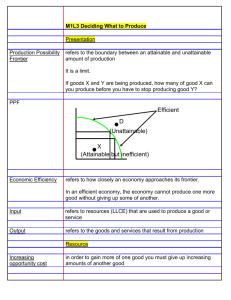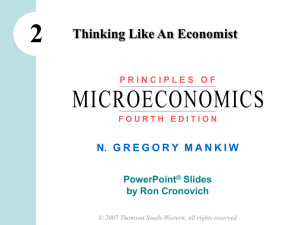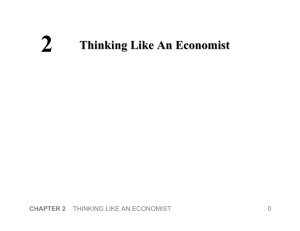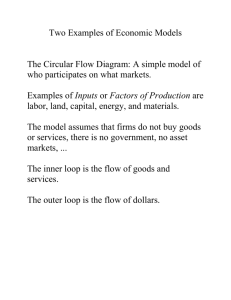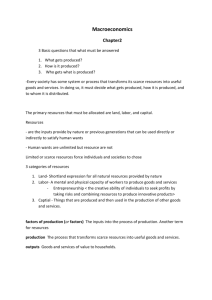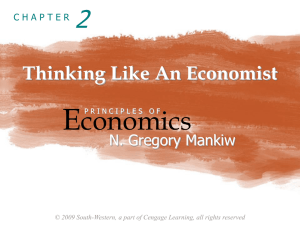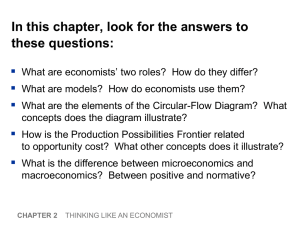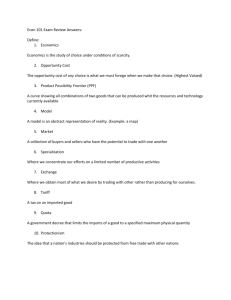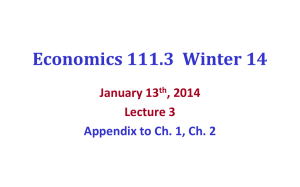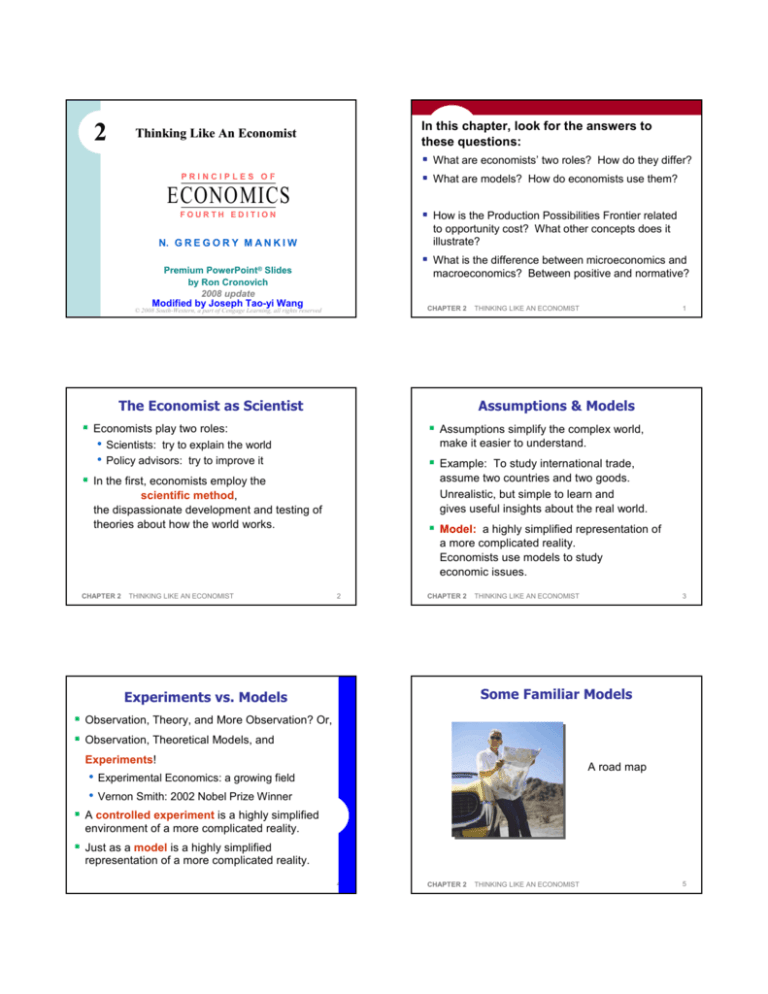
2
In this chapter, look for the answers to
these questions:
What are economists’ two roles? How do they differ?
What are models? How do economists use them?
Thinking Like An Economist
PRINCIPLES OF
ECONOMICS
How is the Production Possibilities Frontier related
FOURTH EDITION
to opportunity cost? What other concepts does it
illustrate?
N. G R E G O R Y M A N K I W
What is the difference between microeconomics and
Premium PowerPoint® Slides
by Ron Cronovich
2008 update
Modified by Joseph Tao-yi Wang
macroeconomics? Between positive and normative?
CHAPTER 2
© 2008 South-Western, a part of Cengage Learning, all rights reserved
The Economist as Scientist
1
THINKING LIKE AN ECONOMIST
Assumptions & Models
Economists play two roles:
• Scientists: try to explain the world
• Policy advisors: try to improve it
Assumptions simplify the complex world,
make it easier to understand.
Example: To study international trade,
assume two countries and two goods.
Unrealistic, but simple to learn and
gives useful insights about the real world.
In the first, economists employ the
scientific method,
the dispassionate development and testing of
theories about how the world works.
Model: a highly simplified representation of
a more complicated reality.
Economists use models to study
economic issues.
CHAPTER 2
THINKING LIKE AN ECONOMIST
2
CHAPTER 2
3
THINKING LIKE AN ECONOMIST
Some Familiar Models
Experiments vs. Models
Observation, Theory, and More Observation? Or,
Observation, Theoretical Models, and
Experiments!
A road map
• Experimental Economics: a growing field
• Vernon Smith: 2002 Nobel Prize Winner
A controlled experiment is a highly simplified
environment of a more complicated reality.
Just as a model is a highly simplified
representation of a more complicated reality.
4
CHAPTER 2
THINKING LIKE AN ECONOMIST
5
Some Familiar Models
Some Familiar Models
A model of human
anatomy from high
school biology class
A model airplane
CHAPTER 2
6
THINKING LIKE AN ECONOMIST
7
THINKING LIKE AN ECONOMIST
An Economic Model:
Some Familiar Models
The model teeth at the
dentist’s office
CHAPTER 2
The Production Possibilities Frontier
The Production Possibilities Frontier (PPF):
Don’t forget
to floss!
A graph that shows the combinations of
two goods the economy can possibly produce
given the available resources and the available
technology.
Example:
• Two goods: computers and wheat
• One resource: labor (measured in hours)
• Economy has 50,000 labor hours per month
available for production.
CHAPTER 2
8
THINKING LIKE AN ECONOMIST
CHAPTER 2
PPF Example
PPF Example
Producing one computer requires 100 hours labor.
Producing one ton of wheat requires 10 hours labor.
Employment of
labor hours
A
B
Production
Computers
Wheat
Computers
Wheat
50,000
0
500
0
40,000
10,000
9
THINKING LIKE AN ECONOMIST
400
1,000
C
25,000
25,000
250
2,500
D
10,000
40,000
100
4,000
E
0
50,000
0
5,000
Production
Point
on
Comgraph puters Wheat
A
500
0
B
400
1,000
C
250
2,500
D
100
4,000
E
0
5,000
Wheat
(tons)
6,000
5,000
E
D
4,000
3,000
C
2,000
B
1,000
A
0
0
100 200 300 400 500 600
Computers
CHAPTER 2
THINKING LIKE AN ECONOMIST
11
ACTIVE LEARNING
1:
ACTIVE LEARNING
Points off the PPF
1:
Answers
Point F:
A. On the graph, find the point that represents
(100 computers, 3000 tons of wheat), label it F.
Would it be possible for the economy to produce
this combination of the two goods?
Why or why not?
100 computers,
3000 tons wheat
Wheat
(tons)
6,000
5,000
Point F requires
40,000 hours
of labor.
Possible but
not efficient:
could get more
of either good
w/o sacrificing
any of the other.
B. Next, find the point that represents
(300 computers, 3500 tons of wheat), label it G.
Would it be possible for the economy to produce
this combination of the two goods?
4,000
3,000
F
2,000
1,000
0
0
100 200 300 400 500 600
Computers
12
ACTIVE LEARNING
Answers
Point G:
300 computers,
3500 tons wheat
Point G requires
65,000 hours
of labor.
Not possible
because
economy
only has
50,000 hours.
1:
13
The PPF: What We Know So Far
Points on the PPF (like A – E)
• possible
• efficient: all resources are fully utilized
Points under the PPF (like F)
• possible
• not efficient: some resources underutilized
Wheat
(tons)
6,000
5,000
4,000
G
3,000
2,000
(e.g., workers unemployed, factories idle)
1,000
Points above the PPF (like G)
• not possible
0
0
100 200 300 400 500 600
Computers
14
CHAPTER 2
The PPF and Opportunity Cost
15
THINKING LIKE AN ECONOMIST
The PPF and Opportunity Cost
Recall: The opportunity cost of an item
Wheat
(tons)
6,000
is what must be given up to obtain that item.
Moving along a PPF involves shifting resources
slope =
–1000
= –10
100
5,000
(e.g., labor) from the production of one good to
the other.
4,000
3,000
Society faces a tradeoff: Getting more of one
2,000
good requires sacrificing some of the other.
1,000
The slope of the PPF tells you the opportunity
0
cost of one good in terms of the other.
0
100 200 300 400 500 600
The slope of a line
equals the “rise
over the run” –
the amount the line
rises when you
move to the right
by one unit.
Here, the
opportunity cost of
a computer is
10 tons of wheat.
Computers
CHAPTER 2
THINKING LIKE AN ECONOMIST
16
CHAPTER 2
THINKING LIKE AN ECONOMIST
17
2:
PPF and Opportunity Cost
ACTIVE LEARNING
ACTIVE LEARNING
2:
Answers
In which country is the opportunity cost of cloth lower?
FRANCE
England, because its PPF is not as steep as France’s.
FRANCE
ENGLAND
ENGLAND
Wine
Wine
Wine
Wine
600
600
600
600
500
500
500
500
400
400
400
400
300
300
300
300
200
200
200
200
100
100
100
100
0
0
0
0
0
0
100 200 300 400
Cloth
100 200 300 400
0
Cloth
18
Economic Growth and the PPF
With additional
resources or an
improvement in
technology,
the economy can
produce more
computers,
more wheat,
Wheat
(tons)
6,000
Cloth
19
The PPF could be a straight line, or bow-shaped
Depends on what happens to opportunity cost
as economy shifts resources from one industry
to the other.
• If opp. cost remains constant,
4,000
PPF is a straight line.
(In the previous example, opp. cost of a
computer was always 10 tons of wheat.)
3,000
2,000
1,000
or any combination
in between.
100 200 300 400
The Shape of the PPF
Economic
Economic
growth
growth shifts
shifts
the
the PPF
PPF
outward.
outward.
5,000
0
100 200 300 400
Cloth
• If opp. cost of a good rises as the economy
0
0
produces more of the good, PPF is bow-shaped.
100 200 300 400 500 600
Computers
20
THINKING LIKE AN ECONOMIST
Why the PPF Might Be Bow-Shaped
•
PPF becomes
steeper
•
opp. cost of
mountain bikes
increases
At point A,
most workers are
producing beer,
even those that
are better suited
to building
mountain bikes.
THINKING LIKE AN ECONOMIST
A
So, do not have to
give up much beer
to get more bikes.
Mountain
Bikes
CHAPTER 2
21
THINKING LIKE AN ECONOMIST
Why the PPF Might Be Bow-Shaped
Beer
As the economy
shifts resources
from beer to
mountain bikes:
CHAPTER 2
Beer
CHAPTER 2
22
CHAPTER 2
THINKING LIKE AN ECONOMIST
At
At A,
A, opp.
opp. cost
cost of
of
mtn
mtn bikes
bikes is
is low.
low.
Mountain
Bikes
23
Why the PPF Might Be Bow-Shaped
Beer
At B, most workers
are producing bikes.
The few left in beer
are the best brewers.
Producing more
bikes would require
shifting some of the
best brewers away
from beer production,
would cause a big
drop in beer output.
CHAPTER 2
Why the PPF Might Be Bow-Shaped
So, PPF is bow-shaped when different workers
At
At B,
B, opp.
opp. cost
cost
of
of mtn
mtn bikes
bikes
is
is high.
high.
have different skills, different opportunity costs
of producing one good in terms of the other.
The PPF would also be bow-shaped when
there is some other resource, or mix of
resources with varying opportunity costs.
• E.g., different types of land suited for
different uses
B
Mountain
Bikes
THINKING LIKE AN ECONOMIST
24
The PPF: A Summary
CHAPTER 2
THINKING LIKE AN ECONOMIST
25
Microeconomics and Macroeconomics
Microeconomics is the study of how
The PPF shows all combinations of two goods
households and firms make decisions
and how they interact in markets.
that an economy can possibly produce,
given its resources and technology.
Macroeconomics is the study of economy-wide
The PPF illustrates the concepts
phenomena, including inflation, unemployment,
and economic growth.
of tradeoff and opportunity cost,
efficiency and inefficiency,
unemployment, and economic growth.
These two branches of economics are closely
intertwined, yet distinct: they address different
questions.
A bow-shaped PPF illustrates the concept of
However, the two theories are uniting with recent
increasing opportunity cost.
progress providing micro-foundation to macro.
CHAPTER 2
THINKING LIKE AN ECONOMIST
26
27
3:
Identifying positive vs. normative
As scientists, economists make
Which of these statements are “positive” and which
are “normative”? How can you tell the difference?
positive statements,
which attempt to describe the world as it is.
As policy advisors, economists make
normative statements,
which attempt to prescribe how the world should be.
Positive statements can be confirmed or refuted,
a. Prices rise when the government increases the
quantity of money.
b. The government should print less money.
c. A tax cut is needed to stimulate the economy.
normative statements cannot.
Govt employs many economists for policy advice.
d. An increase in the price of gasoline will cause an
increase in consumer demand for video rentals.
E.g., the U.S. President has a Council of Economic
Advisors, which the author of this textbook recently
chaired.
THINKING LIKE AN ECONOMIST
THINKING LIKE AN ECONOMIST
ACTIVE LEARNING
The Economist as Policy Advisor
CHAPTER 2
CHAPTER 2
28
29
ACTIVE LEARNING
3:
ACTIVE LEARNING
Answers
3:
Answers
c. A tax cut is needed to stimulate the economy.
a. Prices rise when the government increases the
quantity of money.
Normative, another value judgment.
Positive, describes a relationship, could use data
to confirm or refute.
d. An increase in the price of gasoline will cause an
increase in consumer demand for video rentals.
b. The government should print less money.
Positive, describes a relationship.
Note that a statement need not be true to be
positive.
Normative, this is a value judgment, cannot be
confirmed or refuted.
30
31
Propositions about Which Most
Economists Agree (and % agreeing)
Why Economists Disagree
Economists often give conflicting policy advice.
They sometimes disagree about the validity of
A ceiling on rents reduces the quantity and quality
of housing available. (93%)
Tariffs and import quotas usually reduce general
alternative positive theories about the world.
economic welfare. (93%)
They may have different values and, therefore,
A large federal budget deficit has an adverse effect
different normative views about what policy
should try to accomplish.
on the economy. (83%)
A minimum wage increases unemployment among
Yet, there are many propositions about which
young and unskilled workers. (79%)
most economists agree.
Effluent taxes and marketable pollution permits
represent a better approach to pollution control
than imposition of pollution ceilings. (78%)
CHAPTER 2
THINKING LIKE AN ECONOMIST
32
33
• See how Economists think
• Key Idea: Production Possibility Frontier
• Suggested Homework:
using models with appropriate assumptions.
Simple model: Production Possibilities Frontier.
Microeconomics studies the behavior of
consumers and firms, and their interactions in
markets. Macroeconomics studies the economy
as a whole.
– Read Appendix on Graphing (Mankiw p.38-46)
– Mankiw p.37, Problem 2, 4, 7, 8
As policy advisers, economists offer advice on
how to improve the world.
THINKING LIKE AN ECONOMIST
THINKING LIKE AN ECONOMIST
Chap. 2: Think Like an Economist
CHAPTER SUMMARY
As scientists, economists try to explain the world
CHAPTER 2
CHAPTER 2
34

